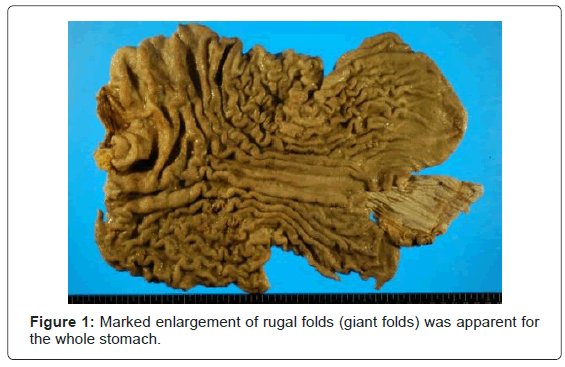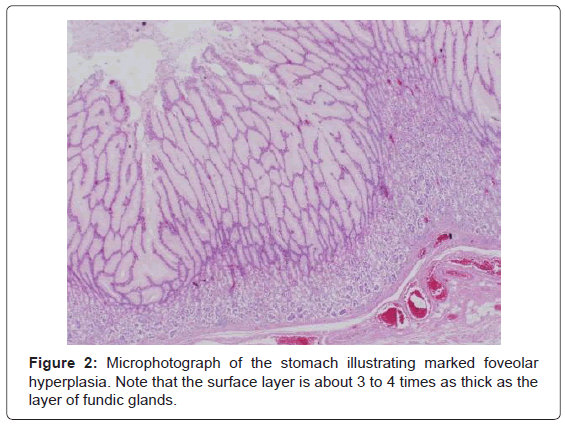Commentary Open Access
Giant Gastric Folds: A Presentation of POEMS Syndrome
Katsuya Chinen*
Department of Pathology, Nerima General Hospital, 1-24-1 Asahigaoka, Nerima, Tokyo, Japan
- *Corresponding Author:
- Katsuya Chinen
Department of Pathology
Nerima General Hospital
1-24-1 Asahigaoka
Nerima, Tokyo, Japan
Tel: 81-3-5988-2200
E-mail: path.chinen@gmail.com
Received date: April 01, 2013; Accepted date: May 29, 2013; Published date: May 31, 2013
Citation: Chinen K (2013) Giant Gastric Folds: A Presentation of POEMS Syndrome. J Gastroint Dig Syst S12:010. doi:10.4172/2161-069X.S12-010
Copyright: © 2013 Chinen K. This is an open-access article distributed under the terms of the Creative Commons Attribution License, which permits unrestricted use, distribution, and reproduction in any medium, provided the original author and source are credited.
Visit for more related articles at Journal of Gastrointestinal & Digestive System
Keywords
Giant gastric folds; POEMS syndrome; Organomegaly
A 42-year-old woman presented with dyspnea on exertion and was diagnosed as having idiopathic pulmonary hypertension (PH). In spite of PH-specific therapies, her PH did not improve. In the clinical course, she presented with polyneuropathy, hepatomegaly, and increased serum level of immunoglobulin G. Four months prior to death, she developed nausea, vomiting, poor appetite, and malnutrition and she eventually died of respiratory failure at the age of 49. An autopsy revealed that the PH was attributed to stenosis of the pulmonary vasculature affected by plasma cell myeloma. In addition, multisystem organomegaly was apparent. Also, marked enlargement of rugal folds (giant folds) was identified throughout the stomach (Figure 1). Histologically, the gastric giant folds were caused by prominent hyperplasia of the foveolar epithelium (Figure 2). Based on the clinical and autopsy findings, the present case was finally diagnosed as PH associated with POEMS syndrome (coined to refer to polyneuropathy, organomegaly, endocrinopathy, M protein, and skin changes) [1].
Giant gastric folds develop in several benign and malignant diseases such as Menetrier disease, anisakiasis, acute gastric mucosal lesion, gastric lymphoma, and scirrhous carcinoma [2]. However, the patient did not have such diseases and the giant gastric folds could be regarded as “gastric organomegaly” in the POEMS syndrome. This case indicates that the POEMS syndrome should be included in the list of differential diagnosis for giant gastric folds.
References
- Chinen K, Fujioka Y (2012) Severe pulmonary hypertension caused by smoldering plasma cell myeloma: an autopsy case of POEMS syndrome. Case Rep Med.
- Okanobu H, Hata J, Haruma K, Hara M, Nakamura K, et al. (2003) Giant gastric folds: differential diagnosis at US. Radiology 226: 686-690.
Relevant Topics
- Constipation
- Digestive Enzymes
- Endoscopy
- Epigastric Pain
- Gall Bladder
- Gastric Cancer
- Gastrointestinal Bleeding
- Gastrointestinal Hormones
- Gastrointestinal Infections
- Gastrointestinal Inflammation
- Gastrointestinal Pathology
- Gastrointestinal Pharmacology
- Gastrointestinal Radiology
- Gastrointestinal Surgery
- Gastrointestinal Tuberculosis
- GIST Sarcoma
- Intestinal Blockage
- Pancreas
- Salivary Glands
- Stomach Bloating
- Stomach Cramps
- Stomach Disorders
- Stomach Ulcer
Recommended Journals
Article Tools
Article Usage
- Total views: 15112
- [From(publication date):
specialissue-2013 - Nov 16, 2025] - Breakdown by view type
- HTML page views : 10448
- PDF downloads : 4664


